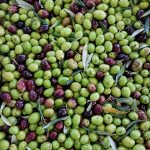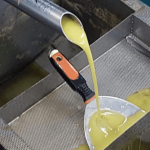Sandi and Tedi Chiavalon have developed the most successful export brand of top-quality Istrian olive oils in the last 20 years. In an interview, they talk about the stages of their business development, the decisions that were the key to the success of the Chiavalon olive oil and the most significant export challenges, reports plavakamenica.hr on January 11, 2019.
Is Croatia seen internationally as an olive-growing country, like Spain or Greece?
The perception varies significantly depending on the market segment. Experts certainly perceive Istria as a serious olive-growing region. The results and achievements in the production of the last fifteen years mean that the Istrian olive-growing is nowadays spoken about with a great deal of respect. On the other hand, we still have to work hard on the popularisation of our extra-virgin olive oils among the wider public, the consumers themselves. Branding a region, a production area, is a long-term job that we must continuously be worked on at multiple levels. This, of course, involves a strategic approach with clearly set goals in the synergy between producers, regions and all ministries – Agriculture, Tourism, Economy, Finance and Foreign Affairs.
Which olive-producing country is the best in branding?
Spain is an excellent example. In addition to Italy and Greece, Spain is undoubtedly the most famous olive-growing country. This year, they launched a major promotion campaign for their olive oils called Olive Oil World Tour. The European Commission supports the campaign. This is the way we have to go if we want to put ourselves on the global map of top-quality olive oil producers that are relevant to consumers around the world.
Are Istrian oils becoming more recognisable as compared to olive oils from Tuscany, Provence or super-premium Spanish oils?
Absolutely, our potential is growing year after year. We are achieving better and better results, and it does not go unnoticed. But for a more serious step forward, and to position Croatia and Istria as a serious olive-growing region, producers need institutional assistance and cooperation. We need a joint master plan with clear goals and specific resources and deadlines. The government should understand that olive oil is one of few Croatian agricultural products that we can say are the best or among the best in the world, and as such is a tremendous economic potential that is currently left unused.
Which phases did Chiavalon pass, from the first steps in international markets to its present status?
There were a lot of stages – sometimes planned, sometimes accidental. If I had to describe them together, I would say that the key is uncompromising work on the quality in all business segments, which we have set as the goal from the very start, and the great passion and love of our entire family towards the work we do.
What was the most important thing for success at each stage?
The unregulated market in Croatia and the impossibility of collecting receivables were probably the main triggers for us to start thinking about exports almost immediately. Another significant moment for our business was the entry of Croatia into the European Union. This has opened an enormous market which functions without administrative barriers we used to encounter, and we have used this in the best possible way. Since entering the EU, our business has increased revenues almost five times.
What would you say is the most critical element for the successful export of Croatian olive oils?
We cannot compete with large olive-growing regions in quantity and in the segment of low cost and medium-range olive oils, so we should not even try to compete there. That is why it is vital that we do not lose focus from producing premium olive oils because that is the only way to differentiate us and position us in the eyes of consumer and experts. Besides, the segment of environmentally-certified products is growing much faster than conventional production, and we certainly should encourage manufacturers to follow that route.
What are the most common mistakes we make in foreign markets?
The most significant limitation is probably the fact that we act independently as producers, without institutional support. Unlike in Italy, Spain or Greece, our producers are creating their own path and thus making a path for others from Croatia, but they are doing it with their resources and money. This is undoubtedly the most crucial obstacle to the faster and more efficient promotion of our oils on the global stage.
Your major export markets are the United States, Japan and Taiwan. Are you planning to expand to additional ones?
We are just finishing export documentation for Peru and Mexico. This will be our first step into the markets of South America. In the next period, we are intensely thinking about Russia and Switzerland, where we want to increase our presence.
Why aren’t there more producers ready to submit their oils to prestigious competitions?
Taking part in such events is very expensive, especially if you want to compete at the world’s major shows. One of the ways in which the government and the ministries could assist in exporting and branding of our olive oils would be to co-finance the costs of sending samples to various events, as well as to co-finance the costs of attending special events. Other olive-growing regions have been doing this for years.
What is the goal of exporters like you, to place their oils in shops or to sell them to restaurants?
We want to reach the target audience, whether it is through direct sales, specialised stores or restaurants. Businesses which offer our olive oil must know everything about us, about our family, about our philosophy and our way of working. Our distributors must be our ambassadors, and that is why we carefully select them and improve our cooperation year after year.
How important are branding and design in your project? Have they influenced your reputation abroad?
Branding and design are essential in creating and promoting every product, including olive oil. We have worked very hard on this, and I would dare to say that we have given the branding and design the same attention as the production itself. Aside from the quality of our oils, we have received many awards for product design. We have won the prestigious Red Dot packaging award, and some of our labels are exhibited at the Museum of Contemporary Art in Essen and in Chicago. The well-conceived design definitely gives added value to the product and differentiates it in the market. We are also very interested in co-branding and co-operation efforts like the one we have with the Jeunes Restaurateurs d’Europe (JRE) in Croatia and Austria.
Could you describe the process of designing a new label and introducing a new brand to the market?
The process is always the same. We start from the idea which we develop ourselves to the smallest details. Then we give this idea to designers who have to turn it into a finished product. The process is fascinating and complex, and we have learned a lot about the basics of industrial design, technology and the problems that we will face during this process. Each product is a new challenge, but we are helped by our partners, designers, printers, packaging makers, photographers and others who are involved in creating a new product. Without them, we would not be what we are today. These are all large and small companies from Croatia, which proves that we know and can realise everything we want to.
More news on the Croatian olive oils can be found in our Lifestyle section.
Translated from plavakamenica.hr.









